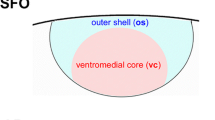Summary
An electron microscopic study has been carried out in order to examine the permeability of the blood-brain barrier in the median eminence of perinatal rats. After several minutes, intravascularly injected electron-dense tracers (lanthanum nitrate; horseradish peroxidase, 40000 MWFootnote 1, ferritin, 500000 MW) pass the capillary wall, the perivascular space, and become incorporated into neurosecretory axons and basal processes of tanycytes both in fetuses and young rats. In the case of immature capillaries, the materials diffuse freely through the endothelial cells, and to a lesser extent are transferred via occasional plasmalemmal vesicles and fenestrae. As the maturation of capillaries proceeds, their permeability via plasmalemmal vesicles and fenestrae increases considerably due to a gradual rise of the number of these structures. The plasmalemmata of the differentiated endothelial cells become impermeable to all of the tracers. Only ionic lanthanum appears to penetrate through transendothelial channels and intercellular junctions between adjacent endothelial cells.
Similar content being viewed by others
Notes
MW: molecular weight
References
Bruns RR, Palade GE (1968) Studies on blood capillaries. II. Transport of ferritin molecules across the wall of muscle capillaries. J Cell Biol 37:277–289
Bugnon C, Fellmann D, Gouget A, Cardot J (1982) Étude immunocytochimique de l'ontogenèse du système neuroglandulaire à CRF chez le rat. C R Acad Sc Paris 294:599–604
Bundgaard M, Frøkjaer-Jensen J (1982) Functional aspects of the ultrastructure of terminal blood vessels: a quantitative study on consecutive segments of the frog mesenteric microvasculature. Microvasc Res 23:1–30
Clementi F, Palade GE (1969) Intestinal capillaries. I. Permeability to peroxidase and ferritin. J Cell Biol 41:33–58
Daikoku S, Kawano H, Abe K, Yoshinaga K (1981a) Topographical appearance of adenohypophysial cells with special reference to the development of the portal system. Arch Histol Jpn 44:103–116
Daikoku S, Adachi T, Kawano H, Wakabayashi K (1981b) Development of the hypothalamohypophysial-gonadotrophic activities in fetal rat. Experientia 37:1346–1347
Deurs B van (1978) Endocytosis in high-endothelial venules. Evidence for transport of exogenous material to lysosomes by uncoated “endothelial” vesicles. Microvasc Res 16:280–293
Donahue S (1964) A relationship between fine structure and function of blood vessels in the central nervous system of rabbit fetuses. Am J Anat 115:17–26
Eurenius L (1977) An electron microscopic study of the differentiating capillaries of the mouse neurohypophysis. Anat Embryol 152:89–108
Flerkó B (1980) The hypophysial portal circulation today. Neuroendocrinology 30:56–63
Glydon RStJ (1957) The development of the blood supply of the pituitary in the albino rat, with special reference to the portal vessels. J Anat 91:237–244
Graham RC, Karnovsky MJ (1966) The early stages of absorption of injected horseradish peroxidase in the proximal tubules of mouse kidney: ultrastructural cytochemistry by a new technique. J Histochem Cytochem 14:291–302
Hammersen F (1966) Porenund Fensterendothelien der Kapillaren in der Skeletmuskulatur der Ratte. Z Zellforsch 69:296–310
Hannah RS (1977) Three-dimensional development of luminal projection and junctional complexes in the developing central nervous system blood vessels of the rat. Cell Tissue Res 175:541–549
Hojvat S, Emanuele N, Baker G, Connicke E, Kirsteins L, Lawrence AM (1982) Growth hormone (GH), thyroid-stimulating hormone (TSH), and luteinizing hormone (LH)-like peptides in the rodent brain: non-parallel ontogenetic development with pituitary counterparts. Dev Brain Res 4:427–434
Johansson BR (1979) Capillary permeability to interstitial microinjections of macromolecules and influence of capillary hydrostatic pressure on endothelial ultrastructure. Acta Physiol Scand Suppl 463:45–50
Jost A, Dupouy J-P, Rieutort M (1974) The ontogenetic development of hypothalamo-hypophysial relations. In: Swaab DF, Schade JP (eds) Integrative hypothalamic activity. Progress in Brain Research Vol 41. Eisevier Scientific Publishing Company, Amsterdam, pp 209–219
Karnovsky MJ (1970) Morphology of capillaries with special reference to muscle capillaries. In: Crone C, Lassen NA (eds) Capillary permeability. The transfer of molecules and ions between capillary blood and tissue. Academic Press, New York, pp 341–350
Mason JC, Curry FE, Michel CC (1977) The effects of proteins upon the filtration coefficient of individually perfused frog mesenteric capillaries. Microvasc Res 13:185–202
Møller M, van Deurs B, Westergaard E (1978) Vascular permeability to proteins and peptides in the mouse pineal gland. Cell Tisssue Res 195:1–15
Muccioli G, Bellusi G, Lando D, di Carlo R (1982) Development of specific binding sites for prolactin in the rabbit hypothalamus. Dev Brain Res 4:244–247
Palade GE, Simionescu M, Simionescu N (1979) Structural aspects of the permeability of the microvascular endothelium. Acta Physiol Scand Suppl 463:11–32
Paull WK (1978) Perinatal neuroendocrine morphology and localization of LHRH in neonatal rats. In: Scott DE et al. (eds) Brain-endocrine interaction III. Neural hormones and reproduction. Karger, Basel, p 16–32
Sibley CP, Bauman KF, Firth JA (1982) Permeability of the foetal capillary endothelium of the guinea-pig placenta to haem proteins of various molecular size. Cell Tissue Res 223:165–178
Ugrumov MV, Mitskevich MS (1980) The adsorptive and transport capacity of tanycytes during the perinatal period of the rat. Cell Tissue Res 211:493–501
Ugrumov MV, Ivanova IP, Mitskevich MS (in press) Light and electron microscopic study of the maturation of the primary portal plexus during the perinatal period in rats. Cell Tissue Res
Wagner RC (1980) Endothelial cell embryology and growth, In: Altura BM (ed) Advances in microcirculation Vo19, Karger, Basel, pp 45–75
Wagner RC, Casley-Smith JR (1981) Endothelial vesicles. Review. Microvasc Res 21:267–298
Wissig SL (1979) Identification of the small pore in muscle capillaries. Acta Physiol Scand Suppl 463:33–44
Author information
Authors and Affiliations
Rights and permissions
About this article
Cite this article
Ugrumov, M.V., Ivanova, I.P. & Mitskevich, M.S. Permeability of the blood-brain barrier in the median eminence during the perinatal period in rats. Cell Tissue Res. 230, 649–660 (1983). https://doi.org/10.1007/BF00216208
Accepted:
Issue Date:
DOI: https://doi.org/10.1007/BF00216208




